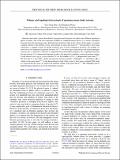Volume and topological invariants of quantum many-body systems
Author(s)
Wen, Xiao-Gang; Wang, Zhenghan
DownloadPublished version (838.9Kb)
Publisher with Creative Commons License
Publisher with Creative Commons License
Creative Commons Attribution
Terms of use
Metadata
Show full item recordAbstract
A gapped many-body system is described by path integral on a space-time
lattice $C^{d+1}$, which gives rise to a partition function $Z(C^{d+1})$ if
$\partial C^{d+1} =\emptyset$, and gives rise to a vector $|\Psi\rangle$ on the
boundary of space-time if $\partial C^{d+1} \neq\emptyset$. We show that $V =
\text{log} \sqrt{\langle\Psi|\Psi\rangle}$ satisfies the inclusion-exclusion
property $\frac{V(A\cup B)+V(A\cap B)}{V(A)+V(B)}=1$ and behaves like a volume
of the space-time lattice $C^{d+1}$ in large lattice limit (i.e. thermodynamics
limit). This leads to a proposal that the vector $|\Psi\rangle$ is the
quantum-volume of the space-time lattice $C^{d+1}$. The inclusion-exclusion
property does not apply to quantum-volume since it is a vector. But
quantum-volume satisfies a quantum additive property. The violation of the
inclusion-exclusion property by $V = \text{log} \sqrt{\langle\Psi|\Psi\rangle}$
in the subleading term of thermodynamics limit gives rise to topological
invariants that characterize the topological order in the system. This is a
systematic way to construct and compute topological invariants from a generic
path integral. For example, we show how to use non-universal partition
functions $Z(C^{2+1})$ on several related space-time lattices $C^{2+1}$ to
extract $(M_f)_{11}$ and $\text{Tr}(M_f)$, where $M_f$ is a representation of
the modular group $SL(2,\mathbb{Z})$ -- a topological invariant that almost
fully characterizes the 2+1D topological orders.
Date issued
2020Department
Massachusetts Institute of Technology. Department of PhysicsJournal
Physical Review Research
Publisher
American Physical Society (APS)